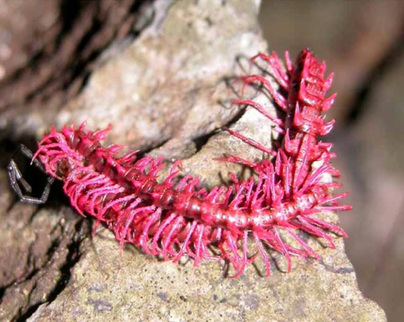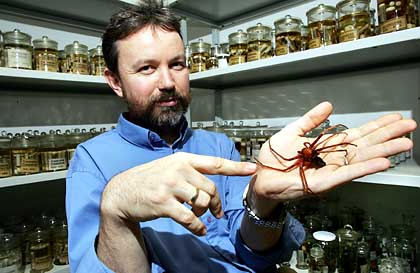1000 New Species
Posted by: Loren Coleman on December 15th, 2008
Perhaps it is only me, but it seems that some “new species” press releases these days are oriented to be a bit over-the-top to get out attention, don’t you think?

Now we have yet another new one just produced by the World Wildlife Fund, entitled “First Contact: New Species Discoveries.”
Statistically, the numbers are large. But we have to take into account that if you pick out a large enough area, say like the greater Mekong region, comprising Cambodia, Laos, Myanmar, Thailand, Vietnam and China’s Yunnan province, then detail all finds from 1997-2007, one would expect a large number of new species. Right?
The report says that more “than 1,000 species – spiders, mammals, snakes and a hot pink, poisonous millipede – have been discovered in the Greater Mekong region…, creating an urgency for environmental groups that fear widespread destruction of the land.”
In the current world of discoveries in our planet, this is very big. Now that the region has stabilized, researchers have been able to go in and document the species. Their findings show it is a major global hotspot for biodiversity, a treasure.
Pete Ewins, director, WWF Canada’s species conservation programs
But why are they confusing “discoveries” with known animals.
The release mentions that the Greater Mekong region is “home to 430 mammal species, including the Asian elephant, Irrawaddy dolphin and Javan rhino, and is one of the last strongholds for the critically endangered Indochinese tiger.” But these mammals were not discovered in the last 12 years.
The majority of new discoveries, which, of course, would include a very few mammals, is definitely more about finding small invertebrate animals.

Peter Jaeger with Heteropoda maxima at the Frankfurter Forschungsinstitut Senckenberg (07.12.05). Photo: Thomas Lohnes/ddp.
The new report documents at least 88 new species of spiders. One of the most significant finds was the Heteropoda maxima, a spider with a leg span of up to 30 cm, considered one of the largest huntsman spiders in the world.
Another new species, which we have discussed on Cryptomundo before, is the Desmoxytes purpurosea or the “dragon millipede.” Hot pink and spiny, the millipede has glands that produce cyanide for its defense. The report says that “several millipedes were found sitting and moving on limestone rocks and on the leaves of Arenga pinnata palms.”
These are all interesting, needless to say, but out of a 1000 new species, most are not large new mammals, as a quick reading of such releases would have the public believe.
I am all for acknowledging the reality of new animals, efforting conservation drives, engaging in habitat preservation, and finding new species. But I feel it undermines the critical and yet exciting nature of all of this by issuing overblown press releases that merge the lines between mammals and spiders to get the public’s support.
Later update and clarification:
The discoveries documented in the WWF report “First Contact” report for the Greater Mekong include 519 plants, 15 mammals, 89 frogs, 279 fish, 46 lizards, 22 snakes, 4 birds, 4 turtles and 2 salamanders.
Among the 15 mammals discovered in the region was the Laotian rock rat, Laonastes aenigmamus.
It was thought to have been extinct for 11 million years but a researcher spotted the corpse of one on sale in a food market in Laos in 2005.
About Loren Coleman
Loren Coleman is one of the world’s leading cryptozoologists, some say “the” leading living cryptozoologist. Certainly, he is acknowledged as the current living American researcher and writer who has most popularized cryptozoology in the late 20th and early 21st centuries.
Starting his fieldwork and investigations in 1960, after traveling and trekking extensively in pursuit of cryptozoological mysteries, Coleman began writing to share his experiences in 1969. An honorary member of Ivan T. Sanderson’s Society for the Investigation of the Unexplained in the 1970s, Coleman has been bestowed with similar honorary memberships of the North Idaho College Cryptozoology Club in 1983, and in subsequent years, that of the British Columbia Scientific Cryptozoology Club, CryptoSafari International, and other international organizations. He was also a Life Member and Benefactor of the International Society of Cryptozoology (now-defunct).
Loren Coleman’s daily blog, as a member of the Cryptomundo Team, served as an ongoing avenue of communication for the ever-growing body of cryptozoo news from 2005 through 2013. He returned as an infrequent contributor beginning Halloween week of 2015.
Coleman is the founder in 2003, and current director of the International Cryptozoology Museum in Portland, Maine.










I disagree. I think the more publicity placed on the importance of biodiversity, the better. If the headline “1000 new species” is what’s required to make people realise what we’re losing on this planet, then that’s the way it has to be.
Further, small pets are becoming ever more popular as people live in higher density cities. Here in Australia, reptile ownership has gone through the roof and you could probably build an empire by capitalising on the trend. Well, maybe not that much, but seriously a few hundred percent increase over the past few years.
Thus, critters like lizards, snakes (and they found a new pit viper – crawling through a restaurant), and even the centipedes and spiders – have vast followings around the world. I read once (H. Axelrod) that fish-keeping is second in popularity as a hobby only to photography – hence info on aquatic fauna is also of interest.
I say keep up the good work to mainstream media that promotes new species discoveries.
(As an aside, on the flipside of the coin, I think news stories about extinctions are also important, even though they don’t have that “feel good / there is hope” connotation).
Chris.
i hate the media. They always seem to blow everything out of proportion ( such as in the article above ) and make links where there aren’t, and pull all the scientific research out of context, ruining it.
i believe that it is important to get the word out about new species, but without blowing it out of proportion just to sell more papers
Usually when dealing with media types there’s 2 directions they go: 1) just enough information to let people know what is going on, but not enough for the general masses to know what is actually happening. several important facts are sometimes left out or 2) the event small, really, but they are going to blow this whole thing out of proportion so it sounds like they are doing something great and important. “The president sneezed. There was a ruckuss trying to get to him. During the confusion I (name your reporter) seized the opportunity to get in close and say ‘Bless you’.” By saying a misleading number they are attempting to rally the masses behind protecting the wildlife in the area. Kudos for “trying to do the right thing”, but I don’t agree with changing the facts to do it. Awesome bugs!
On the one hand, this does conflate a number of discoveries (both individual species and the collections of exeditions) over the past decade, with plants and small invertebrates predominating. And the WWF does mention some charismatic species like the tiger which really don’t have anything to do with “The 1,000.” Nevertheless, I think the press release and accompanying cool pictures make a good point. Round numbers stick in the heads of almost everyone, including media folks and the general public. As long as the number is genuine, throwing it out there can’t hurt the cause of conservation.
Sorry – I think I missed both points. I don’t see how they’re trying to change any facts. Over 1000 species, all new to science, have been described from that region over the past decade, averaging 2 a week.
Further, your criticism should really be directed at the WWF Species Conservation Director whom the media is quoting, shouldn’t it? And I don’t think he’s making ludicrous claims in order to “sell more papers”.
Anyway, the point is a little moot. The articles are out there, conservation is an issue, and the Mekong is a hotspot. None of our discussion will change any of that.
Cheers,
Chris.
While, yes I often agree that the media puts spins on things and not always accurately (This has been a trend over the years of newspapers being more interested in snagging readers’ attention to sell papers, raise ratings, etc. instead of actually just publishing the news).
However, the more important issue for me is that we have new species AND we have a fresh carcass of the rock rat–once again giving credence to the fact that while it was thought extinct for 11 million years, it is not–goes in there with the ceolocanth and adds weight to the argument that just because WE (the collective “we” of scientific and popular thought) think creatures that old could not have survived, well in fact they have.
It gives more weight for the case of sea serpents, dinos in Africa, BF, and a whole multitude of other cryptids…
never thought I’d get excited about a rat…of course I do think the cyanide secreting millipede is much cooler…:)